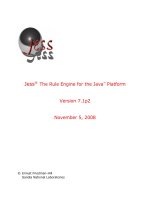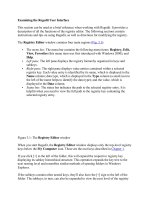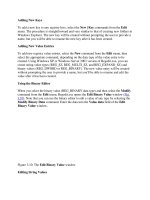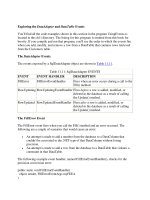Tài liệu Hadoop: The Definitive Guide docx
Bạn đang xem bản rút gọn của tài liệu. Xem và tải ngay bản đầy đủ của tài liệu tại đây (15.93 MB, 686 trang )
THIRD EDITION
Hadoop: The Definitive Guide
Tom White
Beijing
•
Cambridge
•
Farnham
•
Köln
•
Sebastopol
•
Tokyo
Hadoop: The Definitive Guide, Third Edition
by Tom White
Copyright © 2012 Tom White. All rights reserved.
Printed in the United States of America.
Published by O’Reilly Media, Inc., 1005 Gravenstein Highway North, Sebastopol, CA 95472.
O’Reilly books may be purchased for educational, business, or sales promotional use. Online editions
are also available for most titles (). For more information, contact our
corporate/institutional sales department: (800) 998-9938 or
Editors: Mike Loukides and Meghan Blanchette
Production Editor: Rachel Steely
Copyeditor: Genevieve d’Entremont
Proofreader: Kevin Broccoli
Indexer: Kevin Broccoli
Cover Designer: Karen Montgomery
Interior Designer: David Futato
Illustrator: Robert Romano
May 2012: Third Edition.
Revision History for the Third Edition:
2012-01-27 Early release revision 1
2012-05-07 First release
See for release details.
Nutshell Handbook, the Nutshell Handbook logo, and the O’Reilly logo are registered trademarks of
O’Reilly Media, Inc. Hadoop: The Definitive Guide, the image of an elephant, and related trade dress are
trademarks of O’Reilly Media, Inc.
Many of the designations used by manufacturers and sellers to distinguish their products are claimed as
trademarks. Where those designations appear in this book, and O’Reilly Media, Inc., was aware of a
trademark claim, the designations have been printed in caps or initial caps.
While every precaution has been taken in the preparation of this book, the publisher and authors assume
no responsibility for errors or omissions, or for damages resulting from the use of the information con-
tained herein.
ISBN: 978-1-449-31152-0
[LSI]
1336503003
For Eliane, Emilia, and Lottie
Table of Contents
Foreword . . . . . . . . . . . . . . . . . . . . . . . . . . . . . . . . . . . . . . . . . . . . . . . . . . . . . . . . . . . . . . . . . . . xv
Preface . . . . . . . . . . . . . . . . . . . . . . . . . . . . . . . . . . . . . . . . . . . . . . . . . . . . . . . . . . . . . . . . . . . . xvii
1. Meet Hadoop . . . . . . . . . . . . . . . . . . . . . . . . . . . . . . . . . . . . . . . . . . . . . . . . . . . . . . . . . . . 1
Data! 1
Data Storage and Analysis 3
Comparison with Other Systems 4
Rational Database Management System 4
Grid Computing 6
Volunteer Computing 8
A Brief History of Hadoop 9
Apache Hadoop and the Hadoop Ecosystem 12
Hadoop Releases 13
What’s Covered in This Book 15
Compatibility 15
2. MapReduce . . . . . . . . . . . . . . . . . . . . . . . . . . . . . . . . . . . . . . . . . . . . . . . . . . . . . . . . . . . 17
A Weather Dataset 17
Data Format 17
Analyzing the Data with Unix Tools 19
Analyzing the Data with Hadoop 20
Map and Reduce 20
Java MapReduce 22
Scaling Out 30
Data Flow 30
Combiner Functions 33
Running a Distributed MapReduce Job 36
Hadoop Streaming 36
Ruby 36
Python 39
v
Hadoop Pipes 40
Compiling and Running 41
3. The Hadoop Distributed Filesystem . . . . . . . . . . . . . . . . . . . . . . . . . . . . . . . . . . . . . . . 43
The Design of HDFS 43
HDFS Concepts 45
Blocks 45
Namenodes and Datanodes 46
HDFS Federation 47
HDFS High-Availability 48
The Command-Line Interface 49
Basic Filesystem Operations 50
Hadoop Filesystems 52
Interfaces 53
The Java Interface 55
Reading Data from a Hadoop URL 55
Reading Data Using the FileSystem API 57
Writing Data 60
Directories 62
Querying the Filesystem 62
Deleting Data 67
Data Flow 67
Anatomy of a File Read 67
Anatomy of a File Write 70
Coherency Model 72
Data Ingest with Flume and Sqoop 74
Parallel Copying with distcp 75
Keeping an HDFS Cluster Balanced 76
Hadoop Archives 77
Using Hadoop Archives 77
Limitations 79
4. Hadoop I/O . . . . . . . . . . . . . . . . . . . . . . . . . . . . . . . . . . . . . . . . . . . . . . . . . . . . . . . . . . . 81
Data Integrity 81
Data Integrity in HDFS 81
LocalFileSystem 82
ChecksumFileSystem 83
Compression 83
Codecs 85
Compression and Input Splits 89
Using Compression in MapReduce 90
Serialization 93
The Writable Interface 94
vi | Table of Contents
Writable Classes 96
Implementing a Custom Writable 103
Serialization Frameworks 108
Avro 110
Avro Data Types and Schemas 111
In-Memory Serialization and Deserialization 114
Avro Datafiles 117
Interoperability 118
Schema Resolution 121
Sort Order 123
Avro MapReduce 124
Sorting Using Avro MapReduce 128
Avro MapReduce in Other Languages 130
File-Based Data Structures 130
SequenceFile 130
MapFile 137
5. Developing a MapReduce Application . . . . . . . . . . . . . . . . . . . . . . . . . . . . . . . . . . . . 143
The Configuration API 144
Combining Resources 145
Variable Expansion 146
Setting Up the Development Environment 146
Managing Configuration 148
GenericOptionsParser, Tool, and ToolRunner 150
Writing a Unit Test with MRUnit 154
Mapper 154
Reducer 156
Running Locally on Test Data 157
Running a Job in a Local Job Runner 157
Testing the Driver 160
Running on a Cluster 161
Packaging a Job 162
Launching a Job 163
The MapReduce Web UI 165
Retrieving the Results 168
Debugging a Job 170
Hadoop Logs 175
Remote Debugging 177
Tuning a Job 178
Profiling Tasks 179
MapReduce Workflows 181
Decomposing a Problem into MapReduce Jobs 181
JobControl 183
Table of Contents | vii
Apache Oozie 183
6. How MapReduce Works .
. . . . . . . . . . . . . . . . . . . . . . . . . . . . . . . . . . . . . . . . . . . . . . . 189
Anatomy of a MapReduce Job Run 189
Classic MapReduce (MapReduce 1) 190
YARN (MapReduce 2) 196
Failures 202
Failures in Classic MapReduce 202
Failures in YARN 204
Job Scheduling 206
The Fair Scheduler 207
The Capacity Scheduler 207
Shuffle and Sort 208
The Map Side 208
The Reduce Side 210
Configuration Tuning 211
Task Execution 214
The Task Execution Environment 215
Speculative Execution 215
Output Committers 217
Task JVM Reuse 219
Skipping Bad Records 220
7. MapReduce Types and Formats .
. . . . . . . . . . . . . . . . . . . . . . . . . . . . . . . . . . . . . . . . . 223
MapReduce Types 223
The Default MapReduce Job 227
Input Formats 234
Input Splits and Records 234
Text Input 245
Binary Input 249
Multiple Inputs 250
Database Input (and Output) 251
Output Formats 251
Text Output 252
Binary Output 252
Multiple Outputs 253
Lazy Output 257
Database Output 258
8. MapReduce Features .
. . . . . . . . . . . . . . . . . . . . . . . . . . . . . . . . . . . . . . . . . . . . . . . . . 259
Counters 259
Built-in Counters 259
User-Defined Java Counters 264
viii | Table of Contents
User-Defined Streaming Counters 268
Sorting 268
Preparation 269
Partial Sort 270
Total Sort 274
Secondary Sort 277
Joins 283
Map-Side Joins 284
Reduce-Side Joins 285
Side Data Distribution 288
Using the Job Configuration 288
Distributed Cache 289
MapReduce Library Classes 295
9.
Setting Up a Hadoop Cluster . . . . . . . . . . . . . . . . . . . . . . . . . . . . . . . . . . . . . . . . . . . . 297
Cluster Specification 297
Network Topology 299
Cluster Setup and Installation 301
Installing Java 302
Creating a Hadoop User 302
Installing Hadoop 302
Testing the Installation 303
SSH Configuration 303
Hadoop Configuration 304
Configuration Management 305
Environment Settings 307
Important Hadoop Daemon Properties 311
Hadoop Daemon Addresses and Ports 316
Other Hadoop Properties 317
User Account Creation 320
YARN Configuration 320
Important YARN Daemon Properties 321
YARN Daemon Addresses and Ports 324
Security 325
Kerberos and Hadoop 326
Delegation Tokens 328
Other Security Enhancements 329
Benchmarking a Hadoop Cluster 331
Hadoop Benchmarks 331
User Jobs 333
Hadoop in the Cloud 334
Apache Whirr 334
Table of Contents | ix
10. Administering Hadoop . . . . . . . . . . . . . . . . . . . . . . . . . . . . . . . . . . . . . . . . . . . . . . . . . 339
HDFS 339
Persistent Data Structures 339
Safe Mode 344
Audit Logging 346
Tools 347
Monitoring 351
Logging 352
Metrics 352
Java Management Extensions 355
Maintenance 358
Routine Administration Procedures 358
Commissioning and Decommissioning Nodes 359
Upgrades 362
11. Pig . . . . . . . . . . . . . . . . . . . . . . . . . . . . . . . . . . . . . . . . . . . . . . . . . . . . . . . . . . . . . . . . . 367
Installing and Running Pig 368
Execution Types 368
Running Pig Programs 370
Grunt 370
Pig Latin Editors 371
An Example 371
Generating Examples 373
Comparison with Databases 374
Pig Latin 375
Structure 376
Statements 377
Expressions 381
Types 382
Schemas 384
Functions 388
Macros 390
User-Defined Functions 391
A Filter UDF 391
An Eval UDF 394
A Load UDF 396
Data Processing Operators 399
Loading and Storing Data 399
Filtering Data 400
Grouping and Joining Data 402
Sorting Data 407
Combining and Splitting Data 408
Pig in Practice 409
x | Table of Contents
Parallelism 409
Parameter Substitution 410
12. Hive . . . . . . . . . . . . . . . . . . . . . . . . . . . . . . . . . . . . . . . . . . . . . . . . . . . . . . . . . . . . . . . . 413
Installing Hive 414
The Hive Shell 415
An Example 416
Running Hive 417
Configuring Hive 417
Hive Services 419
The Metastore 421
Comparison with Traditional Databases 423
Schema on Read Versus Schema on Write 423
Updates, Transactions, and Indexes 424
HiveQL 425
Data Types 426
Operators and Functions 428
Tables 429
Managed Tables and External Tables 429
Partitions and Buckets 431
Storage Formats 435
Importing Data 441
Altering Tables 443
Dropping Tables 443
Querying Data 444
Sorting and Aggregating 444
MapReduce Scripts 445
Joins 446
Subqueries 449
Views 450
User-Defined Functions 451
Writing a UDF 452
Writing a UDAF 454
13. HBase . . . . . . . . . . . . . . . . . . . . . . . . . . . . . . . . . . . . . . . . . . . . . . . . . . . . . . . . . . . . . . . 459
HBasics 459
Backdrop 460
Concepts 460
Whirlwind Tour of the Data Model 460
Implementation 461
Installation 464
Test Drive 465
Clients 467
Table of Contents | xi
Java 467
Avro, REST, and Thrift 470
Example 472
Schemas 472
Loading Data 473
Web Queries 476
HBase Versus RDBMS 479
Successful Service 480
HBase 481
Use Case: HBase at Streamy.com 481
Praxis 483
Versions 483
HDFS 484
UI 485
Metrics 485
Schema Design 485
Counters 486
Bulk Load 486
14. ZooKeeper . . . . . . . . . . . . . . . . . . . . . . . . . . . . . . . . . . . . . . . . . . . . . . . . . . . . . . . . . . . 489
Installing and Running ZooKeeper 490
An Example 492
Group Membership in ZooKeeper 492
Creating the Group 493
Joining a Group 495
Listing Members in a Group 496
Deleting a Group 498
The ZooKeeper Service 499
Data Model 499
Operations 501
Implementation 506
Consistency 507
Sessions 509
States 511
Building Applications with ZooKeeper 512
A Configuration Service 512
The Resilient ZooKeeper Application 515
A Lock Service 519
More Distributed Data Structures and Protocols 521
ZooKeeper in Production 522
Resilience and Performance 523
Configuration 524
xii | Table of Contents
15. Sqoop . . . . . . . . . . . . . . . . . . . . . . . . . . . . . . . . . . . . . . . . . . . . . . . . . . . . . . . . . . . . . . . 527
Getting Sqoop 527
Sqoop Connectors 529
A Sample Import 529
Text and Binary File Formats 532
Generated Code 532
Additional Serialization Systems 533
Imports: A Deeper Look 533
Controlling the Import 535
Imports and Consistency 536
Direct-mode Imports 536
Working with Imported Data 536
Imported Data and Hive 537
Importing Large Objects 540
Performing an Export 542
Exports: A Deeper Look 543
Exports and Transactionality 545
Exports and SequenceFiles 545
16. Case Studies . . . . . . . . . . . . . . . . . . . . . . . . . . . . . . . . . . . . . . . . . . . . . . . . . . . . . . . . . 547
Hadoop Usage at Last.fm 547
Last.fm: The Social Music Revolution 547
Hadoop at Last.fm 547
Generating Charts with Hadoop 548
The Track Statistics Program 549
Summary 556
Hadoop and Hive at Facebook 556
Hadoop at Facebook 556
Hypothetical Use Case Studies 559
Hive 562
Problems and Future Work 566
Nutch Search Engine 567
Data Structures 568
Selected Examples of Hadoop Data Processing in Nutch 571
Summary 580
Log Processing at Rackspace 581
Requirements/The Problem 581
Brief History 582
Choosing Hadoop 582
Collection and Storage 582
MapReduce for Logs 583
Cascading 589
Fields, Tuples, and Pipes 590
Table of Contents | xiii
Operations 593
Taps, Schemes, and Flows 594
Cascading in Practice 595
Flexibility 598
Hadoop and Cascading at ShareThis 599
Summary 603
TeraByte Sort on Apache Hadoop 603
Using Pig and Wukong to Explore Billion-edge Network Graphs 607
Measuring Community 609
Everybody’s Talkin’ at Me: The Twitter Reply Graph 609
Symmetric Links 612
Community Extraction 613
A. Installing Apache Hadoop . . . . . . . . . . . . . . . . . . . . . . . . . . . . . . . . . . . . . . . . . . . . . . 617
B. Cloudera’s Distribution Including Apache Hadoop . . . . . . . . . . . . . . . . . . . . . . . . . . 623
C. Preparing the NCDC Weather Data . . . . . . . . . . . . . . . . . . . . . . . . . . . . . . . . . . . . . . . 625
Index . . . . . . . . . . . . . . . . . . . . . . . . . . . . . . . . . . . . . . . . . . . . . . . . . . . . . . . . . . . . . . . . . . . . . 629
xiv | Table of Contents
Foreword
Hadoop got its start in Nutch. A few of us were attempting to build an open source
web search engine and having trouble managing computations running on even a
handful of computers. Once Google published its GFS and MapReduce papers, the
route became clear. They’d devised systems to solve precisely the problems we were
having with Nutch. So we started, two of us, half-time, to try to re-create these systems
as a part of Nutch.
We managed to get Nutch limping along on 20 machines, but it soon became clear that
to handle the Web’s massive scale, we’d need to run it on thousands of machines and,
moreover, that the job was bigger than two half-time developers could handle.
Around that time, Yahoo! got interested, and quickly put together a team that I joined.
We split off the distributed computing part of Nutch, naming it Hadoop. With the help
of Yahoo!, Hadoop soon grew into a technology that could truly scale to the Web.
In 2006, Tom White started contributing to Hadoop. I already knew Tom through an
excellent article he’d written about Nutch, so I knew he could present complex ideas
in clear prose. I soon learned that he could also develop software that was as pleasant
to read as his prose.
From the beginning, Tom’s contributions to Hadoop showed his concern for users and
for the project. Unlike most open source contributors, Tom is not primarily interested
in tweaking the system to better meet his own needs, but rather in making it easier for
anyone to use.
Initially, Tom specialized in making Hadoop run well on Amazon’s EC2 and S3 serv-
ices. Then he moved on to tackle a wide variety of problems, including improving the
MapReduce APIs, enhancing the website, and devising an object serialization frame-
work. In all cases, Tom presented his ideas precisely. In short order, Tom earned the
role of Hadoop committer and soon thereafter became a member of the Hadoop Project
Management Committee.
Tom is now a respected senior member of the Hadoop developer community. Though
he’s an expert in many technical corners of the project, his specialty is making Hadoop
easier to use and understand.
xv
Given this, I was very pleased when I learned that Tom intended to write a book about
Hadoop. Who could be better qualified? Now you have the opportunity to learn about
Hadoop from a master—not only of the technology, but also of common sense and
plain talk.
—Doug Cutting
Shed in the Yard, California
xvi | Foreword
Preface
Martin Gardner, the mathematics and science writer, once said in an interview:
Beyond calculus, I am lost. That was the secret of my column’s success. It took me so
long to understand what I was writing about that I knew how to write in a way most
readers would understand.
1
In many ways, this is how I feel about Hadoop. Its inner workings are complex, resting
as they do on a mixture of distributed systems theory, practical engineering, and com-
mon sense. And to the uninitiated, Hadoop can appear alien.
But it doesn’t need to be like this. Stripped to its core, the tools that Hadoop provides
for building distributed systems—for data storage, data analysis, and coordination—
are simple. If there’s a common theme, it is about raising the level of abstraction—to
create building blocks for programmers who just happen to have lots of data to store,
or lots of data to analyze, or lots of machines to coordinate, and who don’t have the
time, the skill, or the inclination to become distributed systems experts to build the
infrastructure to handle it.
With such a simple and generally applicable feature set, it seemed obvious to me when
I started using it that Hadoop deserved to be widely used. However, at the time (in
early 2006), setting up, configuring, and writing programs to use Hadoop was an art.
Things have certainly improved since then: there is more documentation, there are
more examples, and there are thriving mailing lists to go to when you have questions.
And yet the biggest hurdle for newcomers is understanding what this technology is
capable of, where it excels, and how to use it. That is why I wrote this book.
The Apache Hadoop community has come a long way. Over the course of three years,
the Hadoop project has blossomed and spun off half a dozen subprojects. In this time,
the software has made great leaps in performance, reliability, scalability, and manage-
ability. To gain even wider adoption, however, I believe we need to make Hadoop even
easier to use. This will involve writing more tools; integrating with more systems; and
1. “The science of fun,” Alex Bellos, The Guardian, May 31, 2008, />2008/may/31/maths.science.
xvii
writing new, improved APIs. I’m looking forward to being a part of this, and I hope
this book will encourage and enable others to do so, too.
Administrative Notes
During discussion of a particular Java class in the text, I often omit its package name
to reduce clutter. If you need to know which package a class is in, you can easily look
it up in Hadoop’s Java API documentation for the relevant subproject, linked to from
the Apache Hadoop home page at Or if you’re using an IDE,
it can help using its auto-complete mechanism.
Similarly, although it deviates from usual style guidelines, program listings that import
multiple classes from the same package may use the asterisk wildcard character to save
space (for example, import org.apache.hadoop.io.*).
The sample programs in this book are available for download from the website that
accompanies this book: You will also find instructions
there for obtaining the datasets that are used in examples throughout the book, as well
as further notes for running the programs in the book, and links to updates, additional
resources, and my blog.
What’s in This Book?
The rest of this book is organized as follows. Chapter 1 emphasizes the need for Hadoop
and sketches the history of the project. Chapter 2 provides an introduction to
MapReduce. Chapter 3 looks at Hadoop filesystems, and in particular HDFS, in depth.
Chapter 4 covers the fundamentals of I/O in Hadoop: data integrity, compression,
serialization, and file-based data structures.
The next four chapters cover MapReduce in depth. Chapter 5 goes through the practical
steps needed to develop a MapReduce application. Chapter 6 looks at how MapReduce
is implemented in Hadoop, from the point of view of a user. Chapter 7 is about the
MapReduce programming model and the various data formats that MapReduce can
work with. Chapter 8 is on advanced MapReduce topics, including sorting and joining
data.
Chapters 9 and 10 are for Hadoop administrators and describe how to set up and
maintain a Hadoop cluster running HDFS and MapReduce.
Later chapters are dedicated to projects that build on Hadoop or are related to it.
Chapters 11 and 12 present Pig and Hive, which are analytics platforms built on HDFS
and MapReduce, whereas Chapters 13, 14, and 15 cover HBase, ZooKeeper, and
Sqoop, respectively.
Finally, Chapter 16 is a collection of case studies contributed by members of the Apache
Hadoop community.
xviii | Preface
What’s New in the Second Edition?
The second edition has two new chapters on Hive and Sqoop (Chapters 12 and 15), a
new section covering Avro (in Chapter 4), an introduction to the new security features
in Hadoop (in Chapter 9), and a new case study on analyzing massive network graphs
using Hadoop (in Chapter 16).
This edition continues to describe the 0.20 release series of Apache Hadoop because
this was the latest stable release at the time of writing. New features from later releases
are occasionally mentioned in the text, however, with reference to the version that they
were introduced in.
What’s New in the Third Edition?
The third edition covers the 1.x (formerly 0.20) release series of Apache Hadoop, as
well as the newer 0.22 and 2.x (formerly 0.23) series. With a few exceptions, which are
noted in the text, all the examples in this book run against these versions. The features
in each release series are described at a high level in “Hadoop Releases”
on page 13.
This edition uses the new MapReduce API for most of the examples. Because the old
API is still in widespread use, it continues to be discussed in the text alongside the new
API, and the equivalent code using the old API can be found on the book’s website.
The major change in Hadoop 2.0 is the new MapReduce runtime, MapReduce 2, which
is built on a new distributed resource management system called YARN. This edition
includes new sections covering MapReduce on YARN: how it works (Chapter 6) and
how to run it (Chapter 9).
There is more MapReduce material, too, including development practices such as
packaging MapReduce jobs with Maven, setting the user’s Java classpath, and writing
tests with MRUnit (all in Chapter 5); and more depth on features such as output com-
mitters, the distributed cache (both in Chapter 8), and task memory monitoring (Chap-
ter 9). There is a new section on writing MapReduce jobs to process Avro data (Chapter
4), and one on running a simple MapReduce workflow in Oozie (Chapter 5).
The chapter on HDFS (Chapter 3) now has introductions to high availability, federa-
tion, and the new WebHDFS and HttpFS filesystems.
The chapters on Pig, Hive, Sqoop, and ZooKeeper have all been expanded to cover the
new features and changes in their latest releases.
In addition, numerous corrections and improvements have been made throughout the
book.
Preface | xix
Conventions Used in This Book
The following typographical conventions are used in this book:
Italic
Indicates new terms, URLs, email addresses, filenames, and file extensions.
Constant width
Used
for program listings, as well as within paragraphs to refer to program elements
such as variable or function names, databases, data types, environment variables,
statements, and keywords.
Constant width bold
Shows commands or other text that should be typed literally by the user.
Constant width italic
Shows text that should be replaced with user-supplied values or by values deter-
mined by context.
This icon signifies a tip, suggestion, or general note.
This icon indicates a warning or caution.
Using Code Examples
This
book is here to help you get your job done. In general, you may use the code in
this book in your programs and documentation. You do not need to contact us for
permission unless you’re reproducing a significant portion of the code. For example,
writing a program that uses several chunks of code from this book does not require
permission. Selling or distributing a CD-ROM of examples from O’Reilly books does
require permission. Answering a question by citing this book and quoting example
code does not require permission. Incorporating a significant amount of example code
from this book into your product’s documentation does require permission.
We appreciate, but do not require, attribution. An attribution usually includes the title,
author, publisher, and ISBN. For example: “Hadoop: The Definitive Guide, Third Ed-
ition, by Tom White. Copyright 2011 Tom White, 978-1-449-31152-0.”
If you feel your use of code examples falls outside fair use or the permission given here,
feel free to contact us at
xx | Preface
Safari® Books Online
Safari Books Online (www.safaribooksonline.com) is an on-demand digital
library that delivers expert content in both book and video form from the
world’s leading authors in technology and business. Technology profes-
sionals, software developers, web designers, and business and creative
professionals use Safari Books Online as their primary resource for re-
search, problem solving, learning, and certification training.
Safari Books Online offers a range of product mixes and pricing programs for organi-
zations, government agencies, and individuals. Subscribers have access to thousands
of books, training videos, and prepublication manuscripts in one fully searchable da-
tabase from publishers like O’Reilly Media, Prentice Hall Professional, Addison-Wesley
Professional, Microsoft Press, Sams, Que, Peachpit Press, Focal Press, Cisco Press, John
Wiley & Sons, Syngress, Morgan Kaufmann, IBM Redbooks, Packt, Adobe Press, FT
Press, Apress, Manning, New Riders, McGraw-Hill, Jones & Bartlett, Course Tech-
nology, and dozens more. For more information about Safari Books Online, please visit
us online.
How to Contact Us
Please address comments and questions concerning this book to the publisher:
O’Reilly Media, Inc.
1005 Gravenstein Highway North
Sebastopol, CA 95472
800-998-9938 (in the United States or Canada)
707-829-0515 (international or local)
707-829-0104 (fax)
We have a web page for this book, where we list errata, examples, and any additional
information. You can access this page at:
/>To comment or ask technical questions about this book, send email to:
For more information about our books, courses, conferences, and news, see our website
at .
Find us on Facebook: />Follow us on Twitter: />Watch us on YouTube: />Preface | xxi
Acknowledgments
I have relied on many people, both directly and indirectly, in writing this book. I would
like to thank the Hadoop community, from whom I have learned, and continue to learn,
a great deal.
In particular, I would like to thank Michael Stack and Jonathan Gray for writing the
chapter on HBase. Thanks also go to Adrian Woodhead, Marc de Palol, Joydeep Sen
Sarma, Ashish Thusoo, Andrzej Białecki, Stu Hood, Chris K. Wensel, and Owen
O’Malley for contributing case studies for Chapter 16.
I would like to thank the following reviewers who contributed many helpful suggestions
and improvements to my drafts: Raghu Angadi, Matt Biddulph, Christophe Bisciglia,
Ryan Cox, Devaraj Das, Alex Dorman, Chris Douglas, Alan Gates, Lars George, Patrick
Hunt, Aaron Kimball, Peter Krey, Hairong Kuang, Simon Maxen, Olga Natkovich,
Benjamin Reed, Konstantin Shvachko, Allen Wittenauer, Matei Zaharia, and Philip
Zeyliger. Ajay Anand kept the review process flowing smoothly. Philip (“flip”) Kromer
kindly helped me with the NCDC weather dataset featured in the examples in this book.
Special thanks to Owen O’Malley and Arun C. Murthy for explaining the intricacies of
the MapReduce shuffle to me. Any errors that remain are, of course, to be laid at my
door.
For the second edition, I owe a debt of gratitude for the detailed review and feedback
from Jeff Bean, Doug Cutting, Glynn Durham, Alan Gates, Jeff Hammerbacher, Alex
Kozlov, Ken Krugler, Jimmy Lin, Todd Lipcon, Sarah Sproehnle, Vinithra Varadhara-
jan, and Ian Wrigley, as well as all the readers who submitted errata for the first edition.
I would also like to thank Aaron Kimball for contributing the chapter on Sqoop, and
Philip (“flip”) Kromer for the case study on graph processing.
For the third edition, thanks go to Alejandro Abdelnur, Eva Andreasson, Eli Collins,
Doug Cutting, Patrick Hunt, Aaron Kimball, Aaron T. Myers, Brock Noland, Arvind
Prabhakar, Ahmed Radwan, and Tom Wheeler for their feedback and suggestions. Rob
Weltman kindly gave very detailed feedback for the whole book, which greatly im-
proved the final manuscript. Thanks also go to all the readers who submitted errata for
the second edition.
I am particularly grateful to Doug Cutting for his encouragement, support, and friend-
ship, and for contributing the Foreword.
Thanks also go to the many others with whom I have had conversations or email
discussions over the course of writing the book.
Halfway through writing this book, I joined Cloudera, and I want to thank my
colleagues for being incredibly supportive in allowing me the time to write and to get
it finished promptly.
xxii | Preface
I am grateful to my editor, Mike Loukides, and his colleagues at O’Reilly for their help
in the preparation of this book. Mike has been there throughout to answer my ques-
tions, to read my first drafts, and to keep me on schedule.
Finally, the writing of this book has been a great deal of work, and I couldn’t have done
it without the constant support of my family. My wife, Eliane, not only kept the home
going, but also stepped in to help review, edit, and chase case studies. My daughters,
Emilia and Lottie, have been very understanding, and I’m looking forward to spending
lots more time with all of them.
Preface | xxiii









